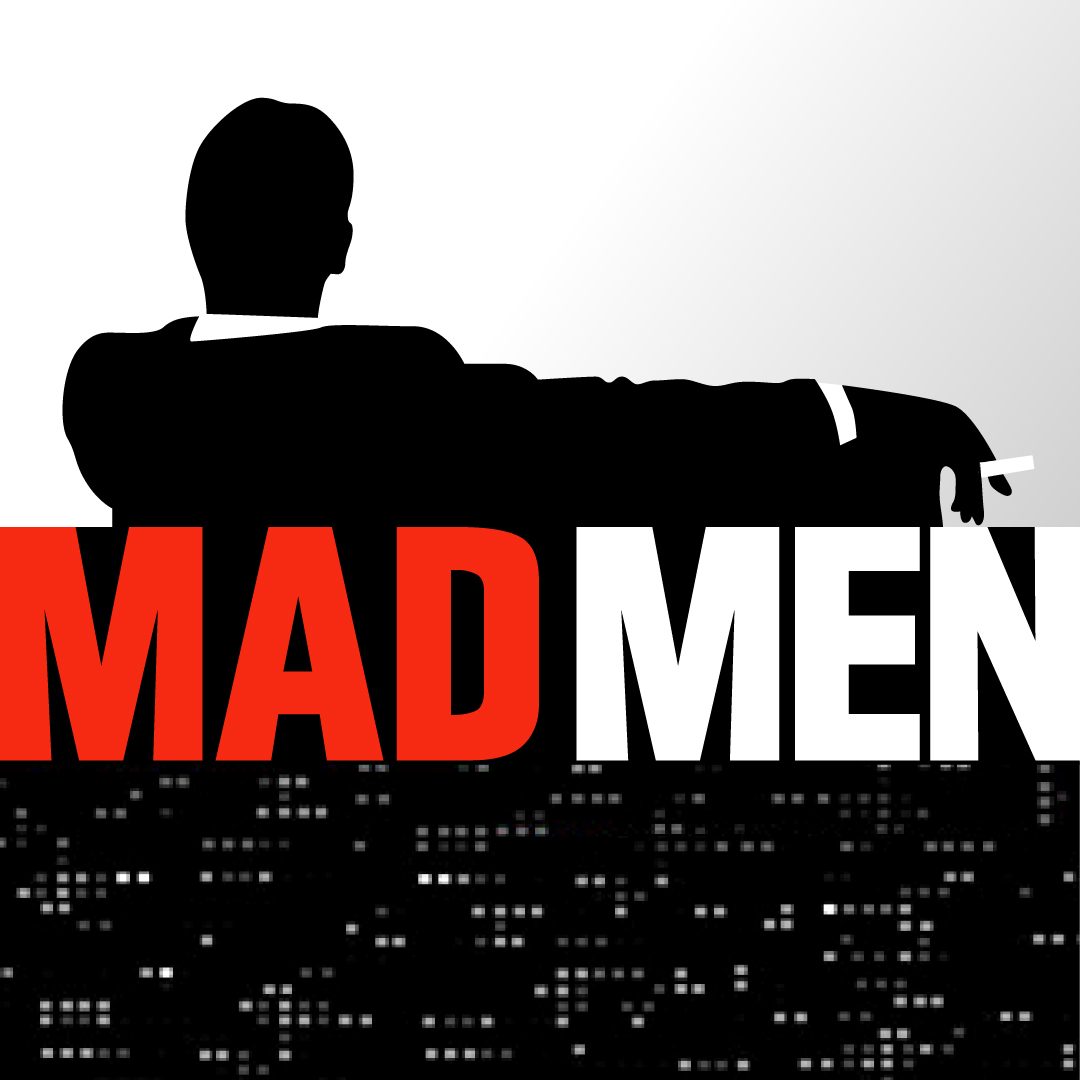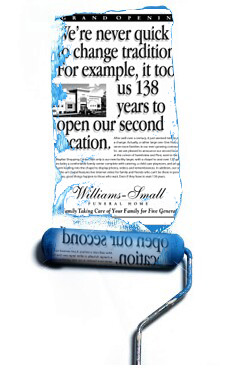 I was having lunch with a friend who is well-respected and recognized in the advertising industry (age of “Mad Men”), when we both started reciting well-known marketing/advertising quotes and how there are as relevant today as they were 40 to 60 years ago. Unfortunately, too many marketing director types immediately dismiss these pearls of marketing wisdom because they think “that was then and this is now.” The problem with that type of thinking is that these people are doomed to make the same mistakes over and over again because they don’t get one important fact: marketing has the same challenges as it did years ago which, in short, is the need to differentiate your message from competitors so people buy your product or do business with you. It’s we just have a lot more channels to contend with today.
I was having lunch with a friend who is well-respected and recognized in the advertising industry (age of “Mad Men”), when we both started reciting well-known marketing/advertising quotes and how there are as relevant today as they were 40 to 60 years ago. Unfortunately, too many marketing director types immediately dismiss these pearls of marketing wisdom because they think “that was then and this is now.” The problem with that type of thinking is that these people are doomed to make the same mistakes over and over again because they don’t get one important fact: marketing has the same challenges as it did years ago which, in short, is the need to differentiate your message from competitors so people buy your product or do business with you. It’s we just have a lot more channels to contend with today.
So, here are five famous marketing/advertising quotes, with a few thoughts on how they relate to your efforts, whether you’re a social media manager, content marketer, or advertiser:
1. “The truth isn’t the truth until people believe you, and they can’t believe you if they don’t know what you’re saying, and they can’t know what you’re saying if they don’t listen to you, and they won’t listen to you if you’re not interesting, and you won’t be interesting until you do and say things imaginatively, originally, freshly.” – Bill Bernbach
My all-time favorite advertising/marketing quote because it really goes to the heart of getting your product or company’s message recognized and acted upon. If you believe what Mr. Bernbach says, and frankly, how can you not, then the whole idea of developing uninspiring, status-quo, “beige” marketing messaging should never be settled for again…ever. Why put forth the effort of creating something that becomes largely invisible to your audience? This quote goes hand in hand with another Bernbach quote: “You can say the right thing about a product and nobody will listen. You’ve got to say it in such a way that people will feel it in their gut. Because if they don’t feel it, nothing will happen.”
2. “When you reach for the stars you might not quite get one, but you won’t come up with a handful of mud either.” – Leo Burnett
I’ve worked both on the agency side as well as the client side and to this date, I’m still shocked at how often the client thinks so little about the growth opportunities for their product or service, while the agency thinks that the product or service is just the “cat’s meow.” Don’t be an “Eeyore-type.” Think big! While there’s also something to be said for having realistic expectations about what you can achieve, there’s nothing wrong with having big dreams and aiming to make them a reality. If you aim a little higher you might just find yourself achieving things that you might not have thought possible.
3. “Why keep a dog and bark yourself?” – David Ogilvy
If you’ve decided that working with a marketing firm is going to help you communicate your value proposition in ways and forms that you otherwise might not have come up with, then believe in the abilities of those you’ve entrusted to do this and step away from playing copywriter or art director. Yes, you’ll know your product much better than the agency in the same way the agency knows how to communicate it to the marketplace much better than you. In short, collaborating is a good thing. Dictating to your marketing partner, well, that’s not how to get the best work done.
4. “I’d rather apologize than to be so timid as to never try and do anything smart or brave.” – Lee Clow
Lee, who created legendary advertising ranging from Apple Computer’s “Think Different” to the Energizer Bunny to Taco Bell’s Chihuahua to California Cooler, knows of which he speaks. The reason these brands became megabrands is because they recognized good work and weren’t afraid, yes, unafraid, to put it out there for the world to embrace. They rejected the status quo. While your company might not ever become a megabrand, it certainly has in it the ability to fascinate your audience more than it does now and in doing so make your competitors say “Why didn’t we think of that!”
5. “On the average, five times as many people read the headline as read the body copy. When you have written your headline, you have spent eighty cents out of your dollar.” – David Ogilvy
The headline or title of your ad, blog post, collateral piece, Twitter post, YouTube video, etc., is the most effective way to get people to give you the 8 seconds of attention that you want before the reader decides to move on to something else. In short, the purpose of your headline is to get people to read your first line. The purpose of your opening line is to get people to read the next one. If you don’t embrace – and more importantly, implement – this principle, you’re going to miss out on a lot of readers. Employ headlines that stop the prospective customer. Don’t let it be anything but scintillating.
“The consumer isn’t a moron; she is your wife.” – David Ogilvy
“Rules are what the artist breaks; the memorable never emerged from a formula.” – Bill Bernbach
“Creativity may well be the last legal unfair competitive advantage we can take to run over the competition.” – Dave Trott
“Stopping advertising to save money is like stopping your watch to save time.” – Henry Ford
“Don’t tell me how good you make it; tell me how good it makes me when I use it.” – Leo Burnett
So take these inspirational quotes to heart and make your advertising and marketing ancestors proud! If you want your brand and products to get more noticed in today’s media-saturated world, you might not have to look any further than the original Mad Men and marketing legends. Their legends for a reason!
####
Rolf Gutknecht is vice president, director of account services for LA ads. To discuss your thoughts with Rolf on this blog or any marketing matters, email via this link, or visit www.LAadsMarketing.com. You can also connect with Rolf on LinkedIn.
 As I write this, my house is in complete disarray. We have a contractor tearing up my girls’ old bedrooms and converting them into a guestroom and an art studio for my wife. It isn’t pretty…but soon will be. As I walk past the tarp and power tools and stepladders, I’m so appreciative that there are people whom I can call on who know how to do this with an assured and desirable outcome. I use experts to prepare my taxes, to check under my engine, to tell me my cholesterol is too high. I leave the do-it-yourself projects to things that have very low consequences if I screw it up.
As I write this, my house is in complete disarray. We have a contractor tearing up my girls’ old bedrooms and converting them into a guestroom and an art studio for my wife. It isn’t pretty…but soon will be. As I walk past the tarp and power tools and stepladders, I’m so appreciative that there are people whom I can call on who know how to do this with an assured and desirable outcome. I use experts to prepare my taxes, to check under my engine, to tell me my cholesterol is too high. I leave the do-it-yourself projects to things that have very low consequences if I screw it up.
Marketing is not a low-consequence endeavor. If it doesn’t succeed, company fortunes and employee livelihoods are at risk. And yet, for too many companies, marketing continues to be a do-it-yourself project.
It doesn’t take an expert to see the results of this by simply flipping through the pages of any newspaper or magazine. Home-made ads are usually the ones you ignore, are plainly designed (or far worse) without style or a fresh point of view. The same goes for websites, Facebook pages, direct mail, radio commercials and company brochures.
D-I-Y is pervasive – but hardly ever persuasive!
We get inquiries all the time from businesses who have been creating their home-made ads and realize that the outcomes haven’t been what they’d wish for. But just as quickly, they pull back, fearful of relinquishing control and suffering sticker shock when they compare the cost of their D-I-Y efforts to professional services. What they’re missing is that by spending money for professional objectivity, expertise and talent, they dramatically increase the chances of their marketing actually having serious bottom-line impact.
The results of making the leap from D-I-Y to seeking out professional help can be dramatic. I’ve seen countless times sizable changes in traffic, sales and inquiries that resulted from putting the marketing in the hands of experts who excel in that craft. That’s how after 20 years, some businesses become overnight successes!
And by “experts,” I’m not talking about letting the shop that designed your banners or flyers design an ad. They’re experts in quick print projects. They’re not a marketing firm or an advertising agency whose portfolio of work comes with recognizable brands; as a result they don’t know how to help you build a long-term competitive position in the marketplace. Nor am I talking about brother Bernie’s kid who took two semesters of computer graphics and makes rock band t-shirt designs.
Every town has ad agencies and marketing firms who can provide you the ideal strategic guidance and talent required to make a difference. As you know, they come in just about every flavor, from one-man shops to multi-floor mega-agencies. Selecting the right company is a matter of chemistry, portfolio, history of success and their desire to win your business. It’s no different than choosing an accountant, contractor or garage mechanic. Price is a factor, but should never be the deciding factor – any more than seeking out the cheapest physician when you’re worried about internal bleeding. (Remember, it’s your company’s life on the line.)
Here are some tips in selecting a marketing provider (or better yet, a marketing partner!):
Just remember, success isn’t about your being able to do everything or know everything. It’s about being able to find the very best resources to complement what you do and know.
That’s why I know when to run to Home Depot myself and when to call on the guys who are ripping out the girls’ closets right about now.
####
Rolf Gutknecht is vice president, director of account services for LA ads. To discuss your thoughts with Rolf on this blog or any marketing matters, email via this link, or visit www.LAadsMarketing.com. You can also connect with Rolf on LinkedIn.
 Oh, the wonder of beautifully crafted taglines. Those few strategically selected words that sum up everything your business stands for and what you want your target audience to know about you. They’ve made companies fortunes by telling people what makes them standout in the sea of sameness. Consider FedEx’s brilliant “When it absolutely, positively has to be there overnight.” Nine simple words that tell FedEx buyers precisely what they’re going to get, while simultaneously informing all of its employees what their mission is. What if FedEx’s slogan was “We ship things!”? Would Nike be as successful if it allowed an executive committee to red-pencil “Just do it” into “When you need great shoes”? How would BMW’s vision change if “The Ultimate Driving Machine” became “Our cars are fun to drive!” My point is that these companies didn’t settle for weak platitudes or vague, generalized statements that could have applied to their competitors. Nope, they decided that they weren’t going to settle. Instead standing out and differentiating themselves was business-critical. Can the same be said for your company and its marketing? Do you have a themeline or slogan that makes you stand out? Is it unique and memorable? Or is it mediocre because somewhere down the line, people settled?
Oh, the wonder of beautifully crafted taglines. Those few strategically selected words that sum up everything your business stands for and what you want your target audience to know about you. They’ve made companies fortunes by telling people what makes them standout in the sea of sameness. Consider FedEx’s brilliant “When it absolutely, positively has to be there overnight.” Nine simple words that tell FedEx buyers precisely what they’re going to get, while simultaneously informing all of its employees what their mission is. What if FedEx’s slogan was “We ship things!”? Would Nike be as successful if it allowed an executive committee to red-pencil “Just do it” into “When you need great shoes”? How would BMW’s vision change if “The Ultimate Driving Machine” became “Our cars are fun to drive!” My point is that these companies didn’t settle for weak platitudes or vague, generalized statements that could have applied to their competitors. Nope, they decided that they weren’t going to settle. Instead standing out and differentiating themselves was business-critical. Can the same be said for your company and its marketing? Do you have a themeline or slogan that makes you stand out? Is it unique and memorable? Or is it mediocre because somewhere down the line, people settled?
Let’s face it, we have a tendency to settle. It’s almost human nature. We settle for something that’s not just quite right, an outfit that isn’t our best look, a job that doesn’t maximize our talents or an ad or website page that’s okay or just “good enough.” While the act of compromise in life, relationships and particularly conflict is an admirable trait, compromise or “settling for” in marketing is a death knell.
You see, the whole point of your marketing activities is to get noticed; get engaged with your audience; and have your work be acted upon to bring in the business. Alternatively, anonymity, swimming in the center of a school of other fish, may be a good survival tactic if you are an anchovy, but it is not a good survival tactic for business. So you have to wonder why so much marketing – and so many marketers – feel the need to play “follow the leader” with respect to marketing trends.
The logic is that if others have done something successfully, you just need to do the same thing. Well, maybe. And then again, maybe not. As we all know, breakthrough products and breakthrough marketing campaigns are not achieved through conformity. Note the word “break” in breakthrough. These are the products and campaigns that break the rules. These are the products and campaigns that use insight, intuition, experience, sensitivity to the marketplace – and arguably the most important thing….courage – to do things differently. To break away from the status quo.
It is certainly true that most companies don’t have that innate insight and courage to be successfully different. We can’t all be like Steve Jobs. But for those are willing to do things differently and well, for those who want their companies to stand out, then the only rule that matters is: You cannot achieve exceptional success through conformity.
To that end, you can have your brand and product/service stand out if you’re willing to take a risk. For starters, ask yourself these three questions:
1. What’s can you say about your company that’s seen as a unique or fresh alternative to your competitors? This can range from the product or service you offer to the way you do business to that of sharing your wisdom. Think beyond the obvious. Dig deeper. Ask yourself a bunch of “So what does that mean?” and “Why would our customer care?” with each answer that’s given.
2. What medium makes the most sense for your brand? The goal is to create a campaign that drives conversation and ultimately revenue. So what imaginative or different ways (to what you’ve been doing) should be explored and implemented. Doing the same thing from one campaign to another, especially given all of the new technological and interesting messaging channels out there, is not only boring but could be seen by management as, well, not a great reflection on yourself.
3. How will you execute your campaign? Don’t risk looking amateurish or wasting time by trying to save money. Engage yourself with people that can help you get to the BIG idea and then help you implement it in a way that you and your executive management team are proud of. You’ll always remember the big successes, while you’ll forget how much money you saved or spent.
Clearly, whether it is investing in advertising, developing a little more creativity, spending the time to follow-up or making the effort to engage with your customers, you can easily elevate your marketing to where it needs to be. Anyways, what progressive marketer wants to settle for second best, or worse, be recognized as mediocre? That doesn’t play well either at the current company or when you need to show your portfolio of work if switching jobs. Instead, risk being brilliant instead.
####
Rolf Gutknecht is vice president, director of account services for LA ads. To discuss your thoughts with Rolf on this blog or any marketing matters, email via this link, or visit www.LAadsMarketing.com. You can also connect with Rolf on LinkedIn.
“Life can only be understood backwards; but it must be lived forwards.” – Soren Kierkegaard
 The last quarter of 2013 is almost history and as we stand poised to welcome 2014 in just 50 days from today, we hope for a future that is successful, rewarding and where dreams will be realized. Having seen the start of more than a few “new business years” during my career, I’ve learned that you can do one of two things in preparation for the coming year. You can yet again try to create a brand new marketing strategy for the coming year or you can pause, look back and do some serious reflecting, resolving to change, or improve some aspect about how you will initiate your future marketing campaigns. For some people, looking back over the past year may be something better left in the rearview mirror; on the other hand, burying your head in the sand can be seen as the primary ingredient in a recipe for another disappointing year…and you know how much the CEO/President/Owner/ Founder loves that kind of thinking and pending poor results. So before one celebrates the dawn of a new year…take time to ask yourself what are you going to do to change? What does success in 2014 look like to you and your executive management team?
The last quarter of 2013 is almost history and as we stand poised to welcome 2014 in just 50 days from today, we hope for a future that is successful, rewarding and where dreams will be realized. Having seen the start of more than a few “new business years” during my career, I’ve learned that you can do one of two things in preparation for the coming year. You can yet again try to create a brand new marketing strategy for the coming year or you can pause, look back and do some serious reflecting, resolving to change, or improve some aspect about how you will initiate your future marketing campaigns. For some people, looking back over the past year may be something better left in the rearview mirror; on the other hand, burying your head in the sand can be seen as the primary ingredient in a recipe for another disappointing year…and you know how much the CEO/President/Owner/ Founder loves that kind of thinking and pending poor results. So before one celebrates the dawn of a new year…take time to ask yourself what are you going to do to change? What does success in 2014 look like to you and your executive management team?
Speaking for myself and our firm, the end of each year is met with a healthy dose of optimism for the coming year. We see 2014 through a lens of hopefulness, that things will indeed get better. Is that just us or will you and your organization also view the coming year with a level of anticipation that you haven’t had for a few years? Hey, it’s been tough for most everyone out there but let’s remember that at least a few organizations — perhaps your own competitors — have fared better than most despite these trying times. So what have they done to plot a course for a more optimistic and profitable path for success in 2014?
Depending on marketplace factors coupled with how well you were able to strategically position and market your company, the past year was either seen as a success or another year of disappointment. Success if you were able to grow your share of the proverbial pie (maybe at the expense of your competitors) or be sufficiently positioned to stay in business to fight the fight for another year. Or disappointment if things didn’t turn out so well because of…(you can fill in the blank). The question that begs to be asked here is, how much of last year’s success or disappointment was because of something you had no control over, such as good luck or bad luck, and how much was because of something you did or didn’t do given how the marketplace presented itself? I’ve found through personal experience this is the time to be totally honest with yourself. As the quote goes: “Being entirely honest with oneself is a good exercise.” – Sigmund Freud
Hey, I’m all for a bit of luck but you probably don’t want to continue betting future success on lucky things happening in the coming year. With this in mind, here are a few questions to ask yourself as thought starters as you begin the process of looking in the rearview mirror to last year and through your windshield to the next:
As marketers, one thing we know for sure is that change will not stop in 2014. The economy will continue to shift on us —hopefully with less drama. But by reflecting back on 2013, taking control of your marketing activities rather than being tossed around by the waves in the marketplace, along with thinking optimistically about what 2014 can hold, 2014 might actually be a year worth celebrating. It will be for us and hopefully will be for you as well.
####
Rolf Gutknecht is vice president, director of account services for LA ads. To discuss your thoughts with Rolf on this blog or any marketing matters, email via this link, or visit www.LAadsMarketing.com. You can also connect with Rolf on LinkedIn.
 When it comes to sharing on social media, there’s you and your network of friends and contacts. These are all the people that you’re connected with on LinkedIn, Facebook, Twitter, email, etc. And like you, these people have their network, in other words, your network’s network. The big secret of social media, not just for your personal brand but for your company is that it’s not about your network per se. It’s not even so much about reaching those in your network. It’s about reaching your network’s network.
When it comes to sharing on social media, there’s you and your network of friends and contacts. These are all the people that you’re connected with on LinkedIn, Facebook, Twitter, email, etc. And like you, these people have their network, in other words, your network’s network. The big secret of social media, not just for your personal brand but for your company is that it’s not about your network per se. It’s not even so much about reaching those in your network. It’s about reaching your network’s network.
So every message you put out there should be something that your network wants to forward. If your network doesn’t want to forward it along to their networks, then your brilliant post or exciting news dies with them. It’s like telling a room full of people you know something wonderful that you would hope they would tell others…but the word never gets out. On the other hand, if you put out content that’s surprising, that teaches, that adds to the conversation, that provokes thought, that taps into a bigger discussion, then people will forward it. In a sense, they reward you for being oh so clever and smart.
For example, I’m of that age where I’m taking more of an interest in insurance-related matters, so I’ve found myself going to New York Life’s Facebook page. There they ask questions, have polls, allow you to fill in the blank on things that directly have to do with insurance; but many other times the content is peripheral – what do you want your legacy to be? How old is the oldest person you know and what makes them special? It’s stuff people comment on a lot. As you may know, what happens then on Facebook is that those comments show up on people’s individual pages as commenting about something on New York Life’s page. So it becomes viral… which is the art of reaching your network’s network.
So what kind of messages are likely to be forwarded, or maybe more importantly, what kind of messages are boring and least likely to be forwarded? Well one kind is the “cat” status update kind you find on Facebook. You know…”I just fed my cat.” “My cat is playing with her new toy.” Cat, dog, people, whatever. We all know this stuff hardly ever gets forwarded. But you know what, brands do the equivalent of “I just fed kitty” updates all the time. How many times have you read “we just got a new product,” or “we’re moving, ” or “our company just hired 10 more people,” “we just painted our building,” etc. Yaaaawn. While it’s not at all wrong to give out that info, just know you’re saying something about yourself that’s not adding value and thus this update goes no further than your immediate circle of connections, if they’re paying attention at all. Oh, and then there’s the type of messaging that you find on LinkedIn and Twitter a lot…the over-populating of meaningless updates and posts without cessation. One post or tweet after another to the point you get tired seeing this person’s face show up on your screen ever again! If the idea of social media marketing is to form relationships with people, then why would you want to undo what you’ve accomplished by over-marketing your company to the point where people say, “I’ve had enough. Buh-bye!”
So what kind of messages generate traffic for business and does get forwarded to your network’s network? It turns out you already saw this in high school when a message of great personal value went out there and was forwarded. I’ll call this “My parents are out of town…bring your own beer” message. This type of update breaks through the rest of the “ho-hum” messages because it does two things: it produces a high emotional response and people like sharing practically useful content to help out their friends, as well as business customers or prospects.
Now I’m not a psychologist but I’ve found through personal experience that the likelihood of sharing content seems to hinge on things that produce an emotional response by means of wonder, joy, anxiety, fear and surprise. I’m sure there are many other motivators but let’s just talk about these for a moment.
As we know, the idea of social media is to create and strengthen relationships with people. We do that by sharing information that they’d like to get, read and pass along to others. That doesn’t happen if what you have to say isn’t interesting and you won’t be interesting until you say and do things imaginatively, originally, freshly.
 When I first started out in this crazy world of advertising and marketing, I had a co-worker who had been in the business for a while (think of the show “Mad Men”) who would pass on “things to know” in endless supply. One of those things that I’ve remembered over the years has to do with the difference between knowledge and wisdom. It goes like this: knowledge is knowing that a tomato is a fruit; wisdom is knowing that you shouldn’t put it in a fruit salad. I’ve said this so many times to friends, co-workers, my kids, etc., that I’m surprised I’m still not tired of saying it. But there’s so much truth in it and it applies especially to the discipline of marketing.
When I first started out in this crazy world of advertising and marketing, I had a co-worker who had been in the business for a while (think of the show “Mad Men”) who would pass on “things to know” in endless supply. One of those things that I’ve remembered over the years has to do with the difference between knowledge and wisdom. It goes like this: knowledge is knowing that a tomato is a fruit; wisdom is knowing that you shouldn’t put it in a fruit salad. I’ve said this so many times to friends, co-workers, my kids, etc., that I’m surprised I’m still not tired of saying it. But there’s so much truth in it and it applies especially to the discipline of marketing.
As marketing folks, regardless of the industry or size of the firm or marketing department, we’re busy trying to learn as much as we can so as to stay up with the times. And there’s so much to learn. Whether it’s new research telling us about how certain demo groups are behaving towards specific marketing channels, to new online tools, to the best lead-generation software, it’s all coming at us at lightning speed. But we have to remember the need to use good judgment given all of this knowledge. You see knowledge – having specific familiarity or understanding about something – is a bit different than having wisdom – being able to discern or judge what is true, right or lasting. In short, to be wise.
So, while all of this knowledge is important — and it is — we need to know what we can depend on and what is just a fad. What will apply tomorrow after “the next best thing” in marketing has burned out and we’re on to the next “next big thing.” So indulge me in the passing on of some marketing wisdom. Think of it as Marketing “Chicken Soup for Soul,” if you catch my drift.
Marketing wisdom is knowing…
So, when you open up your next Google Alert about a specific marketing subject or if someone from upstairs decides to drop off an industry trade journal with a Post-It note saying “maybe we should try this,” it might be worth remembering “Marketing wisdom is knowing what to put in your fruit salad or keep out of it.”
####
Rolf Gutknecht is vice president, director of account services for LA ads. To discuss your thoughts with Rolf on this blog or any marketing matters, email via this link, or visit www.LAadsMarketing.com. You can also connect with Rolf on LinkedIn.
“The truth isn’t the truth until people believe you, and they can’t believe you if they don’t know what you’re saying, and they can’t know what you’re saying if they don’t listen to you, and they won’t listen to you if you’re not interesting, and you won’t be interesting until you say and do things imaginatively, originally, freshly.” – Bill Bernbach
Over the past couple of weeks, in both my personal and business life, it just seems like everywhere I turn, I’m seeing the most uninspired, blah, boring, and unenthused advertising and marketing messaging. From credit unions to food products to retail delivered through TV, direct mail, outdoor, one-sheets/brochures, whatever. You know exactly what I’m talking about. It’s as though A LOT of people got the same memo: create only lifeless, sigh-inducing marketing that doesn’t say anything. As a result, I recall something that the comedian Billy Connelly once said about people who create this kind of stuff. He called them “Beigests” – as in the color beige.
For the purposes of painting a picture of who a “Beigest” is, let’s describe them as constantly striving to turn everything around him or her lukewarm and mediocre. The kind of person who’ll suck the life out of all meaningful messaging, attempt to censor or dilute anything that they don’t get (forget that their audience does get it), water down any sort of strong rationale with weasel words & steer it towards the middle, and constantly strive for “consensus” as they make the world “user friendly” (i.e., rather than make an executive decision, they ask everyone for their opinion. I sometimes wonder if people making the advertising or marketing decisions are genetically incapable of recognizing messaging that stands out, that they simply default to that never vibrant but never offensive color beige.
Let me ask: who loves the color beige? Not many people will respond saying that beige is one of their favorites. But it’s a color, right? So why aren’t more people expressing their love for it…like they do for reds, blues, purples, or whatever your favorite color is. Because beige is insanely boring! It totally lacks enthusiasm which makes the marketing messaging as dull as an accountant’s office.
Our lives are way too busy for us to be attracted to “beige” things. Yet, too many marketers don’t project that same line of thinking toward attracting customers. Decisions are made daily to keep producing and running the same run-of-the-mill, uninspiring stuff…week after week, month after month, year after year.
Keep in mind that when you as a consumer see anything from a company, either your opinion of that company is enhanced or it’s not. There’s no middle ground. You either like them a bit more or you go in the other direction. So, if that’s the case, why do too many marketers turn that compelling, money-making value proposition into a beige “me-too” that each and every one of your competitors could say. Why do you think for one second that someone is going to acknowledge your message? And not only acknowledge it, but take the time to respond, and make a purchase.
I don’t know about you, but I’ve never been bored into buying something. And I’m even going to say that 99% of your customers are with me on this. The marketing you do for your company is an extension of you. You’re the person who’s responsible for communicating the passion of your company. When you talk about your business with others, hopefully your eyes twinkle, your heart begins to race, your voice becomes more dynamic and people are instantly attracted to you. When that show of enthusiasm and excitement happens, no one would confuse you with being boring, right? Of course not. So look at your marketing stuff and see if it reflects that same level of specialness. Or you could always ask friends, colleagues, suppliers or anyone who will be candid with you, “Does this marketing make you want to pick up the phone and call us or know more about us?” If the answer is not an enthusiastic “yes,” then it’s time to start over. Because spending money that can’t produce results never makes CEOs happy. They’re eventually going to see what you produced for the market.
Save your company from being seen as beige. Be a welcomed splash of red. And listen, not only is it possible for you to create a business that is as fascinating as you are, it is necessary. Life’s too short to settle for “blah.”
 Over the weekend, my daughter wanted to update the look of her bedroom to reflect, as she told me on more than one occasion, …the “new her.” Well, as we finished painting and as she started moving the furniture around and bringing new stuff into the room as well, it occurred to me that she was just “refreshing” the look of the room and not “rebranding” who she was as a person. You see, while the color of her room had changed, a lot of other things remained the same because they spoke to who she is and what’s important to her. And the same thing holds true for companies…maybe yours, as well.
Over the weekend, my daughter wanted to update the look of her bedroom to reflect, as she told me on more than one occasion, …the “new her.” Well, as we finished painting and as she started moving the furniture around and bringing new stuff into the room as well, it occurred to me that she was just “refreshing” the look of the room and not “rebranding” who she was as a person. You see, while the color of her room had changed, a lot of other things remained the same because they spoke to who she is and what’s important to her. And the same thing holds true for companies…maybe yours, as well.
And herein lies the question: When the need arises, should you be rebranding or just refreshing your brand?
As we know, rebranding your business can be an intensive process that can literally redefine a company from the ground up. It’s more than just slapping on a new coat of colors. Instead, a rebrand is a complete redo of an already established brand because the brand has become somewhat stale, insignificant, or are just dated. This often happens when the brand has been around for a while, regardless of size or industry. Contributing factors include: aggressive competition, becoming “lost in time” with an aging customer base, or industry changes that begin to turn a company’s brand irrelevant.
However, rebranding a company from the ground up might not be the best bet for several reasons. For one, rebranding a company tends to erase history in the mind of the customer and you not only run the risk alienating current customers but confounding prospective customers. Oh, and don’t forget about the money that’s involved. Still, for many businesses, it’s necessary in order to stay competitive.
However, it is possible to take a small-scale approach by simply refreshing your brand. Think of it as remodeling your home. It’s still the same house that keeps you safe and warm; you’re just replacing the dark brown shag carpeting with hardwood floors and the yellow tile countertops with granite. It’s more of a remodel of your existing brand than a complete rebuild.
Ok, so why should you be considering this option? Well, if your company has been around for a while, maybe it’s time to revitalize your dated look, or make it more appealing to a contemporary audience, or target a new audience, or address current market conditions. This involves revising/reinvigorating a brand’s positioning and branding imagery to ensure that the messaging is not only strategically sound, but that the brand’s look is up-to-date while still keeping much of the brand’s equity. In short, it’s less of an overhaul, and more of a clarification. The brand name is left untouched, but there are changes in the logo design. Maybe it’s the sizing, placement and type of images and graphics to be used or additional shades of brand colors. It could be a new look to your website, packaging or a change in the tagline.
With this in mind, here are five things are worth considering:
Refreshing your brand is no walk in the park. It takes a lot of preparation and hard work to do it right, but it can help to ensure your brand stays fresh and continues to resonate with your customers. What better way to say “hey, we’re changing with the times” than to refresh your company image.
 Businesses everywhere are searching with ever-increasing frenzy for the wonder drug that’s going to help their businesses do more sales. A few years ago it was search engine optimization. Today it’s social media marketing. My take on this is to do your company a favor and save your money because using social media as a pathway to sales is almost certainly not going to work to the degree you want. What? Heresy you say?
Businesses everywhere are searching with ever-increasing frenzy for the wonder drug that’s going to help their businesses do more sales. A few years ago it was search engine optimization. Today it’s social media marketing. My take on this is to do your company a favor and save your money because using social media as a pathway to sales is almost certainly not going to work to the degree you want. What? Heresy you say?
You see, while social media can be a valuable marketing tool, it’s not magic, it is not a miracle, and it cannot and won’t replace everything that came before it. By itself, social media doesn’t work well. I realize what I’m saying is not likely to be well-received, especially with the hundreds of people who have set themselves up as social media experts over the last year. I can understand why people think social media will cure everything, but I challenge anybody reading this to produce a real success story that has led to an actual increase in sales.
Just take a look at the top brands on Facebook (www.fanpagelist.com/category/brands) to see which brands people Like and Follow on Facebook and Twitter respectively. It’s hard not to be amazed. The #20 brand (Skittles) has more fans than there are people who live in Texas! Yup…Texas. Wow! Who needs paid media when you can reach a mass audience for free? Surely that’s an opportunity just too good to miss, right? Surely it makes sense to place a chunk of your limited and stretched marketing budget on a social media expert who promises to get your message out there so that the profits will roll in. Right?
Well, hold on for a reality check. One significant fact is that most of the top social brands continue to invest heavily in traditional media. Coke is near the top of the top brands on Facebook with more than 70 million followers. WalMart has over 30 million. The route to social media success, it seems, runs through traditional channels. Even the exceptions like YouTube and Starbucks are worth looking at. They obviously didn’t grow into superstar brands using Facebook and Twitter but rather use social media to capitalize on brand equity they have already built-up. In fact, when Google started getting serious competition, they started running TV ads. When there’s a product launch, a sale or just about any other occasion where you need to reach a mass audience quickly and effectively, there’s still no substitute for paid media…and the dot com’s know it.
Social media is a long, hard row to hoe. There’s no quick success and very few programs break through. Ask any company in the country and they’ll tell you they have some kind of social media program in place. Some of the more active companies write a few blog posts a week; reply to comments and questions on a daily basis; and update their Twitter and Facebook feeds repeatedly. A tiny, tiny proportion of them are having anything that resembles significant impact. Fact is, Coca-Cola says it can find no correlation between “buzz” on Twitter and actual unit sales. Auto manufacturer Nissan admits it has no idea if social media helps it shift cars. MasterCard can’t tie its social investment to revenues. In fact, there remains little evidence social media does anything to boost brands’ bottom lines.
Our firm’s experience has been pretty much the same. Although LinkedIn groups were helpful in the beginning, Facebook and Twitter were almost useless for the first year. It took awhile to build a following and learn how to develop it before we saw any benefits that justified the effort.
Oh, and let’s not forget about that group of mysterious online people out there that supposedly hold all the cards … the “Influentials.” Tap into them and they’ll disperse your message to the masses, or so some would have us believe. The fact is that in-depth research into the matter finds this whole idea completely baseless. Brands like Apple, Harley Davidson and Trader Joes, for instance, have been able to build an army of passionate followers without an “influencers” strategy.
That doesn’t mean that influence doesn’t exist. It does. TV show host Oprah Winfrey is very influential as doctors are when it comes to health issues, clergy for spiritual issues and so on. However, there’s nothing mysterious about them. Marketers have long used celebrity endorsements, trade marketing and community outreach where appropriate. The truth is that brands are not built by influential people, but by influential ideas. The problem is that so called “influencers” aren’t that much more influential than anybody else. Don’t take my word for this. Go online and do your own research and see for yourself.
Again, social media by itself is not a great way to build a brand. You’re just inserting yourself into an ocean of jumbled voices and are unlikely to stand out. Marketers like to complain about the clutter in traditional media, but in social media it’s so much more cluttered.
So then why use social media at all? The reason is that it is an impactful vehicle for empowering advocacy and we know that’s extremely important for brand health and profitability. Social media, if done right, can capitalize on what brand equity your company has already built up.
So when I hear social media “experts” who make outrageous claims, who state misleading research, who use everything from stories to rumors to masquerade as facts, whose bias renders them short of perspective, and who completely dismiss the power of ‘traditional’ advertising… they’re ONLY, ONLY, voicing their opinion and not “showing me the beef.”
While social media is a vitally important component of an overall effort, it’s no replacement for sound marketing principles.
 A few weeks ago, I was faced with needing to find a new dentist. So, the search began and the more I looked around, the more it showed just how many touchpoints came into play prior to – and after – a selection being made.
A few weeks ago, I was faced with needing to find a new dentist. So, the search began and the more I looked around, the more it showed just how many touchpoints came into play prior to – and after – a selection being made.
As we know, customers experience your brand in numerous ways and each of these touchpoints molds the customer’s impression of your company’s brand. If the brand is a promise you make, then the customer experience is the fulfillment of that promise. The customer experience can’t be left to chance. It has to consistently reinforce the brand promise across every customer touchpoint or the value of the brand itself is at risk.
So, after thinking about what your brand stands for and what sets it apart, it’s time to look outward. After all, if a brand is built and nobody hears it, does it make a sound? In not-so-distant marketing past, reaching consumers meant connecting through just a few channels: a catalog, a radio spot, a store visit, a customer service line, a salesperson…You get the idea. However, the number of channels for reaching customers has exploded in recent years. Think about it: when was the last time you made a major (or even not-so-major) purchase decision, personal or for business, whether a product or service, through a single channel? In fact, it’s more likely that your purchasing decision was made after being reached through a variety of interconnected touchpoints, from social media, to word-of-mouth, to advertising messaging, to conducting research online, to comparison shopping in the store.
Despite the desire to “silo” marketing channels, they’re far more effectively used together than individually. In a Forrester’s research report, it was noted that 33% of new customers involve two or more “trackable touchpoints,” and nearly 50% of repeat customers visit three or more “trackable touchpoints.” And despite the fact that nearly a 50% of the surveyed people believed that social media channels are a great place to discover new products, less than 1% of sales resulted directly from a social media referral. Online search (i.e., Google) and email were much more effective at closing a sale.
That said, your ultimate goal is to have each touchpoint reinforce and fulfill your marketplace promise. The best way to do this effectively is to look at each of your marketing, selling, and servicing processes which then allows you to create a simple touchpoint chart or map that defines your customers’ experiences with your brand.
Keeping this in mind, let’s use the process in looking for a new dentist:
That said, all touchpoints are not created equal. Some will naturally play a larger role in determining your company’s overall customer experience. To determine the touchpoints driving your customers’ overall experience, your organization can use a wide array of techniques ranging from quantitative research to institutional knowledge.
Yes, it’s simple….almost absurdly simple. But stepping into consumers’ shoes is an exercise absolutely too many executives neglect when marketing. We forget to become our own customers–with real, day-to-day concerns–and in the process, we lose sight of the most valuable touchpoint opportunities. Each one is a chance to present your brand and what you stand for.
In other words, having a more refined sense of “touch” has a big impact on how your prospects feel.